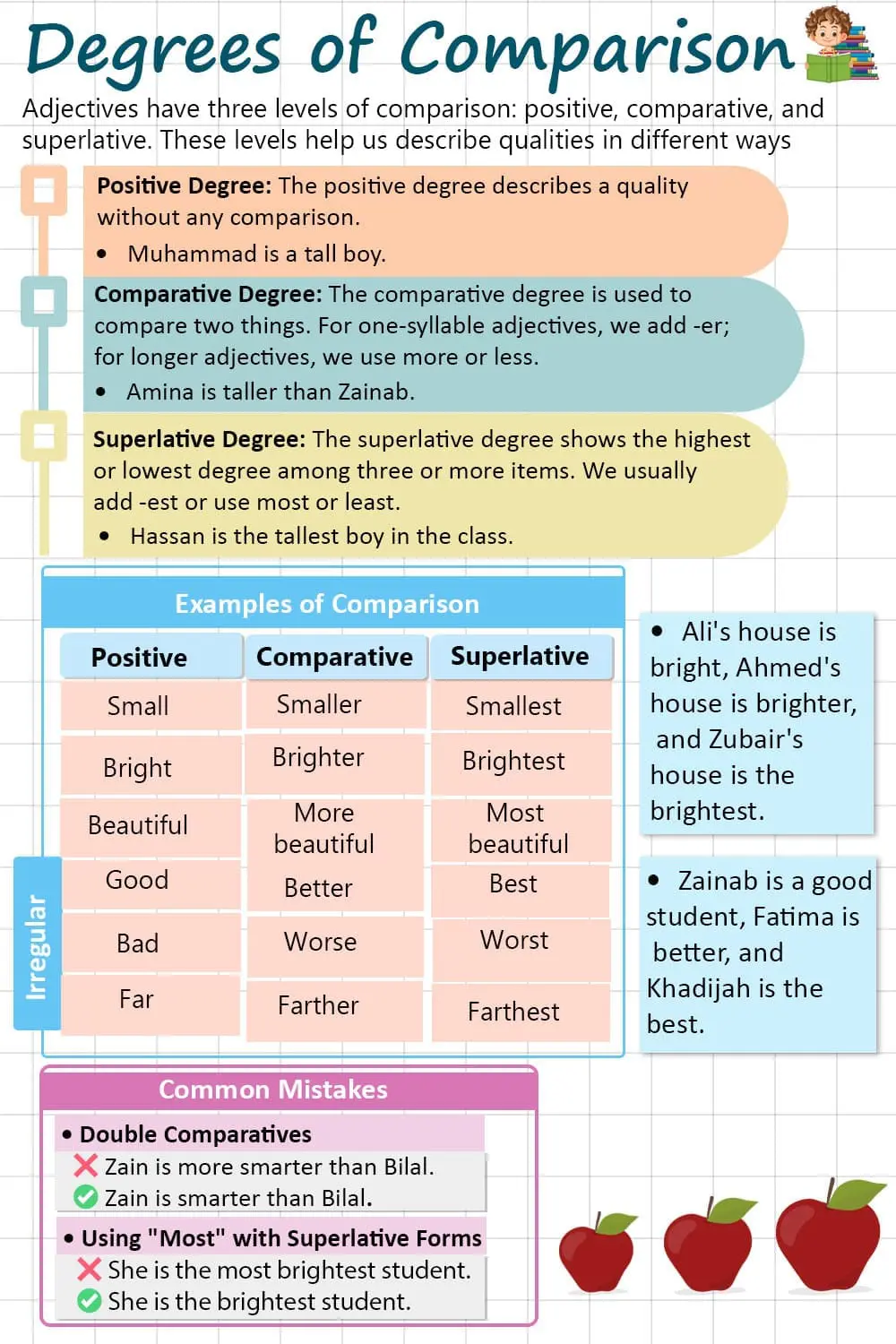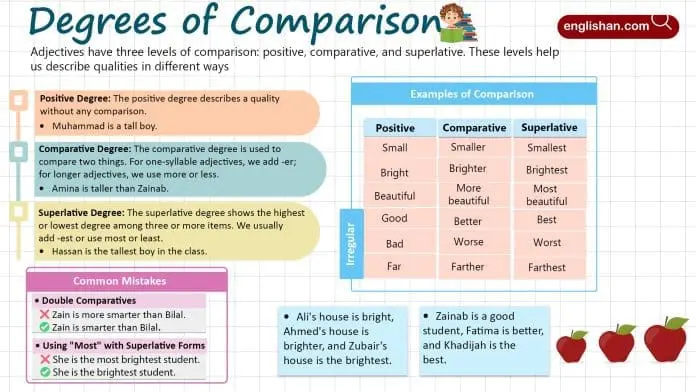Contents
Degrees of comparison show how an adjective changes to compare one thing with another. In English, we use three forms to do this: positive, comparative, and superlative. These help us say if something is equal, better, or best. For example, “fast” is positive, “faster” is comparative, and “fastest” is superlative. Each form tells how much of a quality something has. In this guide, you’ll learn how to use all three degrees correctly with rules, sentence examples, and common mistakes to avoid.

Understanding how adjectives change to compare people, places, or things is essential in English. These changes are known as degrees of comparison, and they help us show different levels of a quality.
What Are the Degrees of Comparison?
In English grammar, adjectives have three forms to show comparison:
- Positive Degree
- Comparative Degree
- Superlative Degree
These degrees allow us to describe qualities clearly—from simple description to comparing two or more things.
Positive Degree
The positive degree describes a quality but does not compare it to anything.
Example:
- Muhammad is a tall boy.
This just tells us that Muhammad is tall. It doesn’t compare him to others.
Comparative Degree
The comparative degree compares two things, showing a higher or lower degree of a quality.
- For short adjectives (usually one syllable), add -er: tall → taller
- For longer adjectives, use more or less: beautiful → more beautiful
Example:
- Amina is taller than Zainab.
Superlative Degree
The superlative degree is used to compare three or more things, showing the highest or lowest level of a quality.
- For short adjectives, add -est: tall → tallest
- For longer adjectives, use most or least: beautiful → most beautiful
Example:
- Hassan is the tallest boy in the class.
Rules for Forming Comparative and Superlative Adjectives
Understanding how to form each degree helps avoid common grammar mistakes. Here are basic formation rules:
- For adjectives ending in -e, just add -r or -st: large → larger → largest
- If the adjective ends in a single vowel + consonant, double the consonant: big → bigger → biggest
- If it ends in -y, change to -i and add -er/-est: happy → happier → happiest
These spelling changes are important to keep your writing accurate.
Degrees of Comparison with Adverbs
Adverbs can also show comparison. Like adjectives, they can appear in three degrees:
- Positive: quickly
- Comparative: more quickly
- Superlative: most quickly
Example:
- She runs more quickly than her brother.
Use “more” or “most” for most adverbs, especially those ending in -ly.
When to Use More vs. -er in Comparisons
It’s not always obvious whether to use -er or more with an adjective. Use this rule:
- One syllable: use -er (e.g., fast → faster)
- Three or more syllables: use more/less (e.g., intelligent → more intelligent)
- Two syllables: depends on the word; both forms may be correct (e.g., clever → cleverer/more clever)
Always choose the form that sounds more natural and is grammatically accepted.
Degrees of Comparison for Two-Syllable Adjectives
Adjectives with two syllables can be tricky. Some take -er/-est, while others need more/most.
Examples:
- narrow → narrower → narrowest
- gentle → more gentle → most gentle
You’ll often hear both forms in casual speech, but formal writing prefers consistency.
Degrees of Comparison Table
Here’s a quick reference list of adjectives in all three degrees:
| Positive | Comparative | Superlative |
|---|---|---|
| small | smaller | smallest |
| bright | brighter | brightest |
| beautiful | more beautiful | most beautiful |
| intelligent | less intelligent | least intelligent |
Example Sentence:
- Ali’s house is bright, Ahmed’s is brighter, and Zubair’s is the brightest.
Irregular Comparisons of Adjectives
Some adjectives do not follow regular patterns. These are called irregular adjectives and must be memorized.
| Positive | Comparative | Superlative |
| good | better | best |
| bad | worse | worst |
| far | farther/further | farthest/furthest |
Example:
- Zainab is a good student. Fatima is better, but Khadijah is the best.
Using Degrees of Comparison in Sentences
Let’s look at how to correctly use these degrees in real sentences:
- ✅ Sara’s cake is more delicious than Aisha’s.
- ✅ Yusuf is the strongest player in the team.
- ❌ Ahmed is the more taller boy in the group. (Wrong)
Note: Never use two comparison forms together (“more taller”). Use only one method.
Common Mistakes in Degrees of Comparison
❌ Double Comparatives/Superlatives
- Incorrect: Zain is more smarter than Bilal.
- Correct: Zain is smarter than Bilal.
❌ Using “most” with Superlative Form
- Incorrect: She is the most brightest student.
- Correct: She is the brightest student.
❌ Confusing “farther” and “further”
- Farther is for physical distance.
- Further can be physical or metaphorical.
Examples:
- He walked farther than anyone else.
- We need to discuss this issue further.
List of Common Adjectives in All Three Forms
This list helps you quickly review how common adjectives change:
| Positive | Comparative | Superlative |
| kind | kinder | kindest |
| strong | stronger | strongest |
| lazy | lazier | laziest |
| important | more important | most important |
Summary: How to Master Adjective Comparisons
- Use the positive degree to describe one thing.
- Use the comparative degree for two things.
- Use the superlative degree for three or more.
FAQs
The three degrees of comparison of adjectives are:
1. Positive: Describes one thing (e.g., big).
2. Comparative: Compares two things (e.g., bigger).
3. Superlative: Compares three or more things (e.g., biggest).
Rule 4 of degrees of comparison states:
When the adjective has two or more syllables, use “more” for the comparative degree and “most” for the superlative degree instead of adding “-er” or “-est” to the word.
Examples:
Positive: beautiful
Comparative: more beautiful
Superlative: most beautiful
This rule helps keep longer adjectives clear and easy to use!
Here are 10 adjectives with their degrees of comparison:
1. Big – Bigger – Biggest
2. Small – Smaller – Smallest
3. Fast – Faster – Fastest
4. Happy – Happier – Happiest
5. Strong – Stronger – Strongest
This list includes both simple and complex adjectives.
The comparison of adjectives is how we show different levels of a quality. There are three types:
1. Positive: Talks about one thing.
Example: This flower is pretty.
2. Comparative: Compares two things.
Example: This flower is prettier than that one.
3. Superlative: Compares three or more things.
Example: This is the prettiest flower in the garden.
It’s simple: Positive = one, Comparative = two, Superlative = three or more!
Here are the simple rules for comparing adjectives:
1. Short adjectives: Add -er for two things and -est for more than two.
Example: Tall – Taller – Tallest
2. Long adjectives: Use more for two things and most for more than two.
Example: Beautiful – More Beautiful – Most Beautiful
3. Adjectives ending in “y”: Change “y” to “i” and add -er or -est.
Example: Happy – Happier – Happiest
Read More
